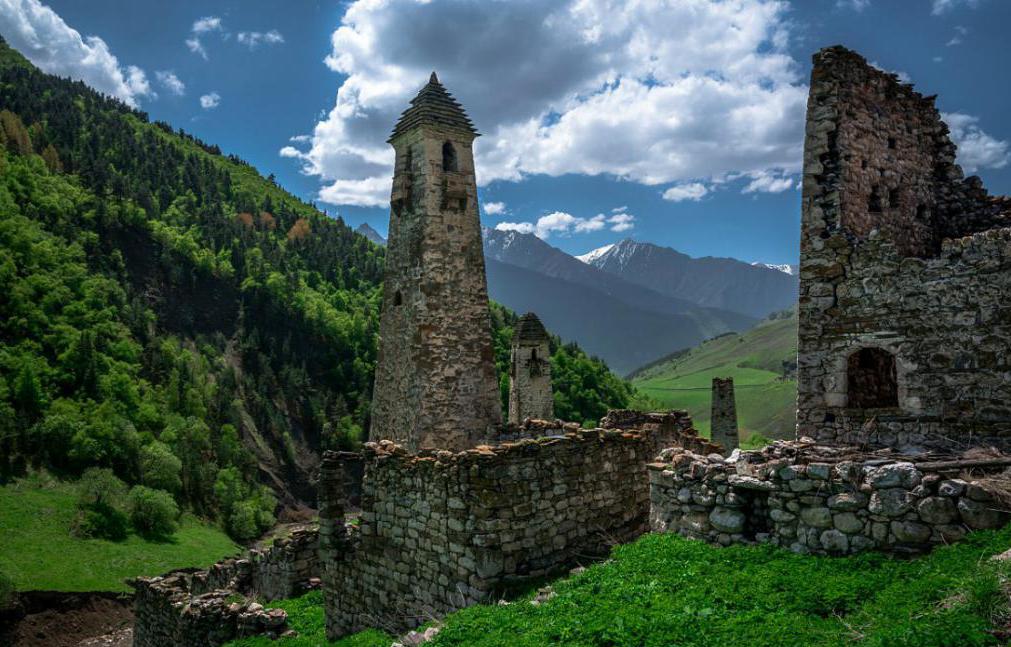The unique monuments of medieval architecture of Ingushetia are monumental residential, signal and guard, defensive and observation buildings made of stone. They are located mainly in the Dzheyrakhsky and Sunzhensky areas of the republic, perfectly combined with the magnificent local nature.
The article presents the story of the Ingush towers (photos are presented below) of the ancient Caucasian villages.
General information
According to scientists, in the North Caucasus tower construction originated in antiquity. Evidence of this is the preserved remains of cyclopean dwellings found in the ancient Ingush villages of Egikal, Targim, Doshkhakle, Hamkhi, Kart, etc. Their age dates back to II - I millennium BC.
At that time, the period of the revival and prosperity of tower culture began in the North Caucasus, which is a phenomenon that manifested itself most clearly in the mountains of Ingushetia. All this was called the "country of towers." In total, currently in the mountains of Ingushetia, there are more than 120 only combat ones. Of this amount, about 50 have a step-pyramidal wedding, about 40 towers are flat-roofed, 30 are unexplored, dilapidated and almost not preserved.
Many monuments and historical places remain unexplored. This is due to difficult accessibility and restrictions (border zones). Today, the history of the Ingush towers is still not completely unraveled.
Types of towers and buildings
Among the main types, there are semi-combat (semi-residential, according to some sources), military and residential towers.
In addition, various religious buildings and necropolises (burial grounds) located in the perimeter of complexes of towers belong to the objects of stone architecture of ancient Ingushetia.
Residential
Ingush towers of this type were most often built with two or three floors and had a rectangular oblong base. The upper part of the structure had a slightly sloping flat roof, but was much narrower in size. In this way, the stability of the structure increased.
Dimensions of towers: at the base - 4–9 meters wide, 6–15 meters long, 9–12 meters high. In the center of the tower, a stone pillar with a square section was installed in the center, which served as a support for the load-bearing beams of wooden floors.
The first floor was usually intended for livestock, and the second and third - for living. The front door was made of oak planks, it was locked with two bolts. To penetrate sunlight, narrow small windows were made in the tower, which were also used as loopholes for defensive purposes. The wooden ceiling was treated with clay above. The walls of residential and semi-battle Ingush towers were covered from above with stones not fastened with mortar, which made it possible, if necessary, to throw them from above at the enemies.
Half battle towers
These structures are an intermediate link between residential and military towers. Their square base was usually much smaller than residential towers. The area was usually about 25 square meters, the height reached 16 meters.
The main distinguishing feature was the absence of a supporting inner pillar and the presence of hinged balconies.
Battle towers
The Ingush tower architecture had the highest flowering during the construction of battle towers. Two types of defensive towers are distinguished: with a pyramidal roof and with a flat one. They were noticeably narrower and higher than semi-combat and residential.
The entrance was on the 2nd floor, which deprived the enemies of the opportunity to use a ram as an attack. Most of the battle towers consisted of five or six floors and their height reached 25-30 meters above the ground, which jeopardized the destruction of stone walls even with a mild earthquake. To enhance the seismic resistance, the 2nd floor was completed with a stone arch, which served as a support for the floors located above and reliably strengthened the walls.

There were also such battle towers (Lyazhgi complex by the masters of Hanoi Hing), which were reinforced with an additional vault between the 4th and 5th floors to give even greater strength. Between floors they moved with the help of attached internal stairs. On the ground floor there were warehouses with food and basic necessities, as well as isolated rooms for prisoners. The remaining floors, except the last, were intended for economic and defensive purposes. The upper floor was called the "tower falcon", used to store stones, bows, arrows and guns.
The Ingush towers of the defensive plan are conical in shape. The most famous tower complex of this type is the Vovnushki complex in the Dzheyrakhsky district of the republic. It is included in the Dzheyrakh-Assinsky museum-reserve.
Masters of construction
Construction craft was sometimes the business of entire Ingush family fraternities (the “professional clan”). Recognized artisans included the well-known genus of the Barkinhoevs living in the villages of Lower, Middle and Upper Odzik. To a greater extent, they specialized in the construction of military towers (“vov”). Such Ingush masters were also famous outside Ingushetia. They were invited to Ossetia, Chechnya, Georgia. They built the most complex tower fortifications and other structures. Ingush towers are the pride of the Caucasian peoples.
Construction skills were inherited. Some folk traditions contain the names of the famous architects of Ingushetia. These are Yand, Dugo Akhriev, Datsi Lyanov, Khazbi Tsurov and others. Among them are the Barkinhoevs.
Finally
There are similar peculiar stone structures in the most remote areas of Dagestan and Chechnya. The Ingush towers of Ossetia and Georgian Svaneti are an architectural landmark of these places. In the Dzheyrakhsky district of Ingushetia itself there is a Targimskaya basin, in which real cities from towers are piled.
Among the huge number of buildings there are also “skyscrapers” reaching the height of a ten-story modern building.
And today medieval stone villages continue to live. Long-lasting and magnificent buildings are a clear example of the ingenious work of Ingush masters.